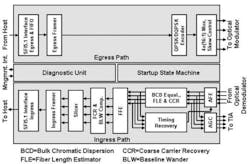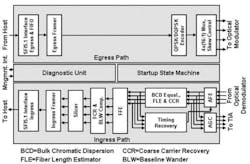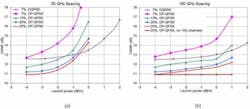The advantages of dual-polarization quadrature phase-shift keying (DP-QPSK) modulation with coherent detection for long-haul and submarine channels are well known. Improved sensitivity and elimination of optical dispersion compensation result in considerable cost savings, as the number of amplifiers can be reduced and network design simplified. As demand for capacity continues to increase, carriers are now considering deployment of coherent technology in metropolitan and regional networks, where 40-Gbps links today are predominantly based on direct-detection differential phase-shift keying (DPSK) or differential QPSK (DQPSK).
Metro/regional mesh networks are characterized by a large number of relatively short (10-80 km) spans, interconnected by ROADM switches, with optical amplifiers and dispersion compensation incorporated to give essentially zero loss and zero dispersion between nodes. Compared to DPSK and DQPSK, DP-QPSK coherent technology has distinct advantages as network speeds increase from 10 Gbps to 40 Gbps. DP-QPSK uses a symbol rate half that of DQPSK and one-quarter that of DPSK, and consequently has a much narrower spectrum. Additionally, DPSK and DQPSK often use RZ instead of NRZ, further broadening their spectra. The narrower spectrum of DP-QPSK results in less distortion for metro/regional networks with cascaded ROADMs.
Metro networks are also trending to “colorless networks,” that is, networks without specific wavelengths assigned to individual add/drop ports.1 For colorless networks, the narrow spectrum of DP-QPSK can eliminate the need for a transmit filter when using a simple combiner instead of a more costly WDM multiplexer to combine wavelengths. With coherent detection, dropping wavelengths in a colorless network can be accomplished simply by tuning a local oscillator laser, instead of requiring a wavelength-selective switch. Eliminating such lossy optical components reduces the need for optical amplification, resulting in further cost savings.
For all of the advantages of 40G coherent DP-QPSK signals in metro/regional applications, there is one hurdle that must be overcome when deploying this technology on legacy networks. Cross-phase modulation (XPM) can impair DP-QPSK signals when combined with 10G on/off-keyed (OOK) channels on fully dispersion compensated WDM links.2 Possible mitigation techniques include skipping channels to reduce XPM or assigning 10G OOK signals and 40G DP-QPSK channels to different bands, separated by guardbands. However, such methods waste valuable spectrum and reduce flexibility of network deployment. Others have proposed the use of more costly coherent binary PSK (BPSK), with an associated doubling of the spectrum required.
Fortunately, there is a relatively simple method to deal with the impairments caused by XPM. Powerful forward error correction (FEC) codes at 40 Gbps, originally developed for submarine channels, can drive very high pre-FEC error rates essentially to zero. The high overhead of these codes is not problematic with DP-QPSK because of its relatively narrow spectrum. In fact, the high overhead can actually help alleviate XPM as it increases the baud rate difference between the 10G and 40G channels.2 These codes are commercially available today in Optical Transport Network (OTN) mapper/framer chips that are already deployed in many existing telecom systems.
DP-QPSK FEC experiment
An experiment was recently performed to quantify the advantage of combining DP-QPSK with high-gain FEC.3 The DP-QPSK waveform was generated and received by a monolithic CMOS transceiver chip employing technology available in commercially available 40-Gbps transceiver chips. A block diagram of the transceiver is shown in Figure. 1.4 The transceiver chip supports line rates up to 50 Gbps, allowing use of high-overhead codes to maximize coding gain.
The 40G OTN Ultra-FEC (UFEC) used on the DP-QPSK channel is constructed with two orthogonally interleaved block codes (BCH) and is based on the scheme described in [5, Appendix I.7]. It is commercially available in the Cortina Systems CS60xx and CS604x family of 40G and 10G OTN processors. The FEC overhead is configurable from 7% to 26%. High coding gain is realized with an iterative hard decision decoding algorithm. For comparison purposes, the DQPSK signal used a 7% EFEC that is compliant with [5, Appendix I.4] and has similar net coding gain to the 7% UFEC code.
Figure 2 shows the experimental setup. The 40G signal under test was placed in the center of six 10G OOK aggressor channels spaced at either 50 GHz or 100 GHz. The 40G channel and the adjacent two 10G channels on either side were individually polarization scrambled, and then all seven channels were combined using two 100-GHz arrayed waveguide gratings (AWGs) followed by an 88-channel 50-GHz interleaver. An 88-channel ROADM was used to balance the power on all channels to within +/- 0.5 dB. The channels then traversed six spans, each consisting of 40 km of standard singlemode fiber (SSMF) followed by an optical amplifier and a dispersion compensating module (DCM) that canceled the dispersion in the 40-km span. The channels then passed through an 88-channel ROADM that again balanced the power on each channel to within +/- 0.5 dB. Additionally, a full C-Band polarization scrambler was placed in front of each power balancing ROADM. The OSNR was controlled by attenuating the multiplexed channels before passing through a high-gain amplifier. There was a final ROADM/demux that separated the aggressor channels and the channel under test.
Results and conclusion
Figures 3a and 3b show the optical signal-to-noise ratio (OSNR) required to drive the post-FEC bit error rate (BER) essentially to 0 for different FEC coding schemes of various overheads, for 50-GHz and 100-GHz channel spacing, respectively. Consider first the 50-GHz channel spacing results. As can be seen, as the launch power of the wavelengths increased, the OSNR required to close the link increased due to XPM. With 7% FEC, DQPSK is less sensitive to this effect than DP-QPSK is. But the higher-gain FECs improved the performance of DP-QPSK, reducing the penalty significantly. The crossover launch power at 13% overhead is approximately -1.5 dBm. At 20% and 25% overhead, the crossover launch power is in the -0.8 dBm to -0.6 dBm range.
Turning our attention to the 100-GHz channel spacing, the 7% coded DQPSK again outperformed the 7% coded DP-QPSK at all launch powers tested due to XPM-induced phase noise. However, with the 13% code, the DP-QPSK showed good tolerance to the XPM aggressors and outperformed the 7% DQPSK channel up to a launch power of +0.5 dBm. Using the 20% and 25% overhead codes, the DP-QPSK XPM tolerance is excellent, outperforming the 7% coded DQPSK channel at all launch powers tested, including launch powers of +1 dBm.
The above results can be translated to number of spans supported by a given OSNR. The phase noise due to XPM is roughly proportional to the product of the span launch power and the number of spans traversed. Increasing launch power requires a proportional decrease in the number of spans to meet the FEC threshold with the same OSNR. Figure 4 shows the received OSNR required to support a given number of spans when the launch power is 0 dBm at 50-GHz spacing (Figure 4a) and 100-GHz spacing (Figure 4b).
For comparison, suppose the network is designed to deliver a received OSNR of 14 dB. With 50-GHz channel spacing (Figure 4a), a 25% coded DP-QPSK supports 11 spans, close to the 13 spans supported by the 7% coded DQPSK. At 100-GHz spacing (Figure 4b), the 13% code achieves 15 spans at 14 dB OSNR, and the 20% and 25% coded DP-QPSK outperforms DQPSK at all span counts tested.
Use of high-gain FEC solves the XPM sensitivity of 40G coherent DP-QPSK and enables combination with 10G OOK links on legacy metro and regional networks. Some have argued that coherent 40G requires use of more expensive BPSK; however, FEC can mitigate the effects of XPM and enable use of cost-effective and bandwidth-efficient DP-QPSK. The channels analyzed here represent extremely challenging channels – dispersion compensated networks with 10G neighboring aggressors. A more benign greenfield application will show even better performance for DP-QPSK.
By solving the XPM issue, high-gain FEC opens the door for use of 40G coherent in metro applications, offering improved performance, cost-reduced network elements, and a stronger, less fractured 40G supply chain.
References
1. S. Gringeri, et al., “Flexible architectures for optical transport nodes and networks,” IEEE Comm. Mag., vol. 48, no. 7, pp. 40-50, Jul. 2010.
2. M. Bertolini, et al., “On the XPM-induced distortion in DQPSK-OOK and coherent QPSK-OOK hybrid systems,” in Optical Fiber Communication Conference, 2009, vol. 2, no. 3, pp. 9-11.
3. N. Swenson, et al., “Use of High Gain FEC to Counteract XPM in Metro Networks Combining 40G Coherent DP-QPSK and 10G OOK Channels,” in IEEE Photonics Conference, 2012.
4. D. Crivelli, et al., “A 40nm CMOS single-Chip 50Gb/s DP-QPSK/BPSK transceiver with electronic dispersion compensation for coherent optical channels,” in ISSCC Dig. Tech. Papers, Feb. 2012.
5. ITU, “Forward error correction for high bit-rate DWDM submarine systems,” ITU-T Recommendation G.975.1 (02/2004), 2005.
Norman L. Swenson is chief technology officer of ClariPhy. He can be reached at [email protected].




